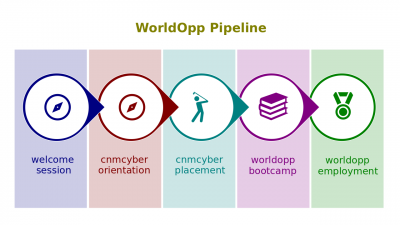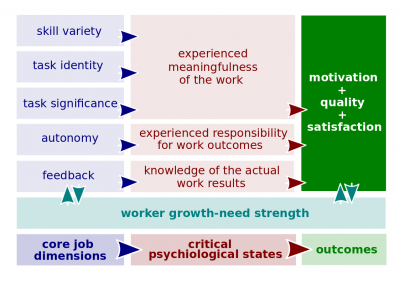Difference between revisions of "Job Dimensions"
(→Script) |
|||
| (20 intermediate revisions by 2 users not shown) | |||
| Line 1: | Line 1: | ||
[[Job Dimensions]] (hereinafter, the ''Lectio'') is the second [[lectio|lesson part]] of the '''[[Nature of Work]]''' [[lesson]] that introduces its participants to [[work characteristic]]s and related topics. | [[Job Dimensions]] (hereinafter, the ''Lectio'') is the second [[lectio|lesson part]] of the '''[[Nature of Work]]''' [[lesson]] that introduces its participants to [[work characteristic]]s and related topics. | ||
| − | [[File:Educaship-pipeline.png|400px|thumb|[[WorldOpp Pipeline]]]]This ''lesson'' belongs to the [[Introduction to Employment]] session of the [[ | + | [[File:Educaship-pipeline.png|400px|thumb|[[WorldOpp Pipeline]]]]This ''lesson'' belongs to the [[Introduction to Employment]] session of the [[EmployableU Concepts]]. |
| Line 7: | Line 7: | ||
The predecessor [[lectio]] is [[Work Arrangements]]. | The predecessor [[lectio]] is [[Work Arrangements]]. | ||
| − | + | [[File:Job-characteristics.png|400px|thumb|right|[[Job Characteristics Model]]]] | |
| − | |||
| − | |||
| − | |||
| − | |||
| − | |||
| − | |||
===Script=== | ===Script=== | ||
| Line 24: | Line 18: | ||
:[[Autonomy]] is the degree to which a job provides substantial freedom, independence, and discretion to the individual in scheduling work and determining the procedures to be used in carrying it out. The level of ''autonomy'' influences ''employee's'' perception of the job responsibility. | :[[Autonomy]] is the degree to which a job provides substantial freedom, independence, and discretion to the individual in scheduling work and determining the procedures to be used in carrying it out. The level of ''autonomy'' influences ''employee's'' perception of the job responsibility. | ||
| − | :As a ''core job dimension'', [[feedback]] refers to the | + | :As a ''core job dimension'', [[feedback]] refers to the scope, promptness, and constructiveness of information about the ''employee's'' performance. |
| − | :The ''Model'' doesn't take into consideration | + | :The ''Model'' doesn't take into consideration [[work demand]]s and other [[work context]]s, as well as the degree of ''employee's'' control over the ''task''. Finally, the ''Model'' doesn't address those factors that demotivate an ''employee'', for instance, the degree of retaliation for possible errors of the ''employee'' who has to make time sensitive decisions. |
| + | |||
| + | ===Key terms=== | ||
| + | :[[Job Characteristics Model]], [[skill variety]], [[task identity]], [[task significance]], [[autonomy]], [[feedback]], [[core job dimension]] | ||
| + | |||
| + | ===Closing=== | ||
| + | :Is the [[Job Characteristics Model]] explained well? --Yes/No/No opinion for now | ||
'''[[Task Attributes]]''' is the successor [[lectio]]. | '''[[Task Attributes]]''' is the successor [[lectio]]. | ||
| − | == | + | ==Questions== |
| + | |||
| + | ===Placement entrance exam=== | ||
Latest revision as of 21:30, 29 October 2023
Job Dimensions (hereinafter, the Lectio) is the second lesson part of the Nature of Work lesson that introduces its participants to work characteristics and related topics.
This lesson belongs to the Introduction to Employment session of the EmployableU Concepts.
Content
The predecessor lectio is Work Arrangements.
Script
- The Job Characteristics Model is the framework that addresses those factors that motivate an employee. The model identifies five core job dimensions, their interrelationships, and their impact on one's work outcomes. These dimensions have been identified while analyzing that job characteristics lead to higher performance. According to the Model, an employee should experience meaningfulness of the job, its responsibility, and know the evaluation of job's stakeholders.
- Three dimensions influence employee's perception of the job meaningfulness. They are skill variety, task identity, and task significance. Skill variety refers to the variety of work activities that require various skills and talents to apply at a particular job. Task identity is the degree to which a job requires completion of a whole and identifiable piece of work. Task significance refers to the job's impact on the lives or work of other people.
- Autonomy is the degree to which a job provides substantial freedom, independence, and discretion to the individual in scheduling work and determining the procedures to be used in carrying it out. The level of autonomy influences employee's perception of the job responsibility.
- As a core job dimension, feedback refers to the scope, promptness, and constructiveness of information about the employee's performance.
- The Model doesn't take into consideration work demands and other work contexts, as well as the degree of employee's control over the task. Finally, the Model doesn't address those factors that demotivate an employee, for instance, the degree of retaliation for possible errors of the employee who has to make time sensitive decisions.
Key terms
- Job Characteristics Model, skill variety, task identity, task significance, autonomy, feedback, core job dimension
Closing
- Is the Job Characteristics Model explained well? --Yes/No/No opinion for now
Task Attributes is the successor lectio.

